
- Review contents
- Pro shooter's report
- Design & tech overview
- Image quality & test shots
- Performance results
- Video results
- Final conclusion
- Discuss the A99
Sony Alpha SLT-A99 Design & Features
On this page:
Camera Overview
Design & Features Walkthrough
Technical Info
Sony Alpha A99 Overview
Though Sony already had an impressive full-frame camera, the company completely rethought their flagship SLR with the introduction of the Alpha A99. Instead of forging new classic design as the A900 did, the Sony A99 builds on the design of the speedy A77, a more modern look with sloping shoulders and organic curves. As expected, the Sony A99 includes a full-frame version of the company's Translucent Mirror Technology, using a transparent mirror to reflect a small amount of light up to a phase-detect sensor just beneath the Sony logo. This eliminates the traditional moving mirror, allowing for faster frame rates and constant autofocus, rather than the necessarily interrupted focus of other professional SLR systems. It also means the A99 uses an electronic viewfinder rather than optical. The kicker is, the Sony A99 doesn't stop there: it also integrates phase-detect sensors in the imaging sensor itself for even greater accuracy. It's unclear why they needed this extra boost -- perhaps to tune one system with the other, or to handle more difficult subjects -- but it's hard to discount the value of extra autofocus sensors.
The rest of the Sony A99's features read like a checklist of amazing technology you'd need if you wanted to make a camera to challenge the hegemony of Nikon and Canon in the professional marketplace: A 35mm 24.3-megapixel Exmor CMOS sensor, 14-bit RAW files, Sensor-shift image stabilization, Sweep Panorama mode, Full HD video at 60p, Dual SD/Memory Stick slots, Max ISO of 25,600, continuous full-frame shooting at up to 6fps (10fps in Tele-zoom mode), and stereo microphone and headphone jacks, just to hit on a few high points. (See below for more technical details.)
The Sony Alpha A99 started shipping at US$2,800 body-only in November 2012.
Sony Alpha A99 Design & Features Walkthrough
As seems fitting for a pro camera, the Sony A99 is a bit larger than the A77, measuring 5.78 x 4.37 x 3.08 inches (147 x 111 x 78mm) and weighing one pound, 12.7 ounces (812g) with battery and a Memory Stick PRO Duo loaded. Its body is made of a combination of magnesium alloy and "high rigidity engineering plastic." It feels substantial and solid.
A warm, leather-textured rubber grip combines some of my favorite features, including a recess for the middle finger for quick alignment and a mild indent inside the grip for the tips of the fingers. In that finger groove is an infrared port, and above that is the front command dial. The red window between the shutter button and Sony logo marks the resurrection of one of my favorite features from the Canon EOS Elan: a red multi-line AF assist projection, something usually only seen on large flash units. Bravo Sony.
A depth-of-field preview button appears lower-left of the lens mount, and it can show a remarkable difference on the A99's high-res LCD and also the higher-resolution OLED viewfinder. Inside the Alpha mount, you can see the transparent mirror, which never moves, and the reflection of the gold contact pins above give you an idea of the mirror's angle. A small round button left of the A99 logo is marked with a C, indicating it's a custom button whose purpose can be programmed to adjust up to 31 functions, including ISO, Exposure Compensation, Drive mode, and more. (Indeed, the AEL, ISO and AF/MF buttons can also be programmed to adjust these 31 parameters if you want to make the Sony A99 uniquely your own.) The D-shaped button is the lens release. Below that is where it gets interesting.
The new Silent multi-controller, lower right of the lens mount, is a smooth-turning dial with a button in the middle. Press the button to activate the menu, or press and hold it to change the dial's function on the fly. One of the menu items, Select AF Area, is probably the most useful, allowing you to press the button and turn the dial to select among the available AF points. What kind of AF points are available is a big topic better explored below.
The Mode dial is a burly plastic and rubber affair with a lock button in the middle. Unlike most pro cameras, there are Scene modes, in addition to Sweep Panorama, Movie and Tele-Zoom 10fps mode, all available with a twist of the dial. Nice stereo microphone grills decorate the top of the Sony A99, and a truly unique hot shoe sits behind that.
Not only does it mark a return to the industry-standard hot shoe, the new Multi Interface Shoe integrates 21 data contacts up underneath the top of the shoe for connection of special peripherals. So not only is it conveniently compatible with older flashes as well as the new HVL-F60M flash, it can support impressive peripherals, like the new XLR adapter kit for improved audio performance and compatibility.
A power switch rings the shutter button, and other buttons are pretty self-explanatory. The inclusion of a Status LCD is a nice touch as well. From this angle you can also see the Four-way joystick sticking out from the back of the Sony A99, a very handy control.
Here's where it gets complicated. You've seen the buttons and dials on the front, the buttons and dials on the top, and now there's quite an array on the back as well. Since this is a two-hand camera, the Menu button is just fine where it is on the upper left, and harder to press accidentally. No problem. There's also ample room for the thumb on the right. But then there's quite a thicket of buttons on the right. I have to say, though, they did just fine. It's all easy to identify and press without hitting the wrong thing accidentally. I could see learning this by heart after a short time. But it's not an easy thing to figure out whether the item you need to adjust is on the front panel's Silent multi-controller, on the top Status display, in the Menu, on the Function button, or does it perhaps have its own button? Walking around town, I found as long as I stuck to PASM and the basic defaults, I was fine. Once I started to dig a bit, it was easy to lock myself out of one function for the sake of another, and figuring out which had interfered was a bit of a detective story not worth repeating here.
Don't even get me started on the AF Range control. What a wonderful use of digital technology, allowing you to pre-define a focus limit area using a simple onscreen graphical scale. If you want to make the camera stay focused on the players in the field while ignoring the spectators walking in front of you, just press the AF Range button and use the front and rear dials to define an area. Simple.
If you didn't bring a long enough lens and just want to crop in the camera, you can press the Smart Teleconverter Button and crop to a 10 or 4.6-megapixel file at 1.4 or 2.0x magnification, respectively.
I also like the joystick for quick navigation. It's not as long as the one on the A700, but it seems far less likely to break.
Once you figure it out, the Sony A99's articulating LCD is pretty versatile, but figuring it out the first time or two might take some trial and error. The difficulty is a consequence of the display only rotating 270 degrees vs a full 360, so there's a particular direction you need to rotate it for any given shooting situation. For example, shooting low-level verticals requires that you flip out the hinged part, and then rotate the screen counterclockwise (moving the top away from you) to get it to a "portrait" orientation looking up at you. It sounds complicated, but it's not actually that bad, since it won't move if you try to rotate it in the wrong directions initially; if you hit the stop, just reverse directions and you're set. A little confusing at first, display adjustment becomes second nature as you spend more time with the camera.
Once my eye's in place and the electronic viewfinder is on, the experience with the EVF is quite good. I love having the fine-resolution level display right there in the viewfinder, helping keep the image square with the horizon. What frustrates me still is the slight hesitation when switching between the LCD and EVF. Shooting on the street, as people moved into position, I sometimes found myself staring into a black viewfinder for a half-second or so, while the action I saw forming up passed me by. I'm pretty sure I'd have to lock it into one or the other mode and just leave it there for anything requiring a quick reaction. As it is, the new rear Status display is quite good, with icons for easy adjustment, and even the levels feature is present, along with a live histogram, exposure info, battery status and other important features.
Overall, there's no question Sony has created an incredible photographic tool, one advanced amateurs and pros will enjoy learning and using, although there may be a bit too much complexity for more casual shooters. In their effort to experiment with new interfaces, Sony may have been overzealous, offering too many ways to set this or that parameter. What you think of it depends on your perspective. If you take the time to familiarize yourself with the Sony A99, its multi-modal interface should make it feel like a part of you, but you'll have to commit to climbing a bit of a learning curve to get there. From what we've seen, though, it's well worth the effort. Thankfully, accessing cool Sony features like Sweep Panorama and the 10fps crop mode still only requires a quick turn of the Mode dial. For more in-depth information on the Sony A99 and its features, see our tech write-up below.
Sony Alpha SLT-A99 Technical Info
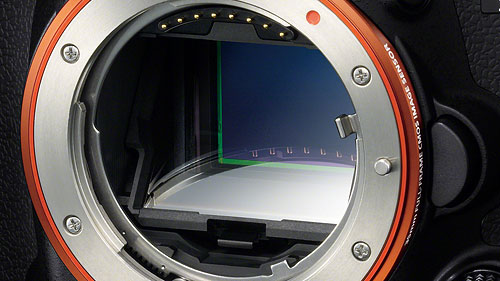
The big news for the Sony Alpha SLT-A99 is to be found at its very heart. This is the first Translucent Mirror model to feature a 35mm full-frame sized image sensor. Every SLT model to date has been based around an APS-C sized image sensor, with less than half the light-gathering area of that in the Sony A99.
The gigantic Translucent Mirror in the Sony A99 redirects a portion of the incoming light to a dedicated phase-detection autofocus sensor in the top of the camera body, near where the viewfinder prism would be in a standard SLR. The remaining light continues through the mirror to the image sensor, providing for the full-time live view feed.
Like any Translucent Mirror camera, the design does mean that there's no true optical viewfinder; instead the Sony SLT-A99 is reliant on an electronic viewfinder.
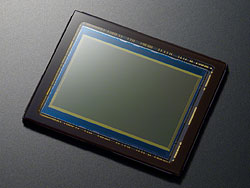
|
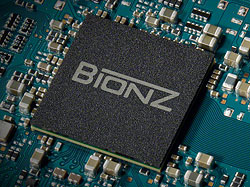
|
|
Behind the mirror sits the newly developed, full-frame Exmor CMOS image sensor. Effective resolution is 24.3 megapixels, with a 3:2 aspect ratio. Total resolution is 24.7 megapixels. Sony says that compared to the previous design, this new chip has larger photo diodes and better microlenses. The new sensor also adds on-chip phase detection points; we'll come back to that in a minute. The sensor assembly is mounted on a movable platter that allows both for sensor-shift image stabilization, and dust removal. Over the sensor, Sony has placed a multi-segment low-pass filter that it says is based on tech from its broadcast division, and will better fight moiré. |
Output from the new imager is handled by a Sony Bionz image processor, also newly-developed for the Alpha A99. The new processor must process lots of data: the A99 shoots 24 megapixel images at six frames per second for as many as 15 Extra-Fine JPEG or 14-bit raw frames. It also allows the Sony A99 to process phase-detect data both from the dedicated AF sensor and on-sensor phase-detect points, and includes new noise reduction algorithms. These, says Sony, will detect the image content, then adapt noise reduction across the image as needed. Sensitivity ranges from ISO 100 to 25,600 (expandable as low as ISO 50). Multi-Frame NR takes this as high as ISO 51,200 equivalent. |
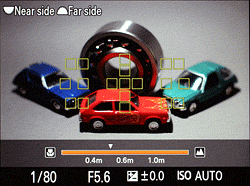
|
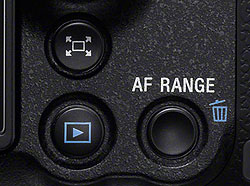
|
|
The Sony SLT-A99 is the world's first camera to feature a dual phase detection system, combining both a dedicated phase detection autofocus sensor, and phase detection points on the main image sensor. (We've seen dual systems before, but only combining phase and contrast-detection systems.) The dedicated phase detection autofocus sensor has 19 user-addressable points, of which 11 points are cross-types, sensitive to both horizontal and vertical detail. There are 102 on-sensor focus points, meanwhile, which serve only to assist in determining focus, and so can't be directly addressed by the user. |
These AF points are used in Sony's new Depth Map Continuous AF (AF-D) mode. This allows you to specify a range within which to focus, preventing issues with the camera focusing away from your subject when it's briefly obscured by a foreground object, or your subject falls out of the autofocus area. The Sony A99's new AF-D focus mode, along with the more common AF-A and AF-C modes, all include predictive control. Other AF features include eye-start AF, microadjustment, and a dedicated AF assist lamp. You can also focus manually, with a peaking function available to help out. |
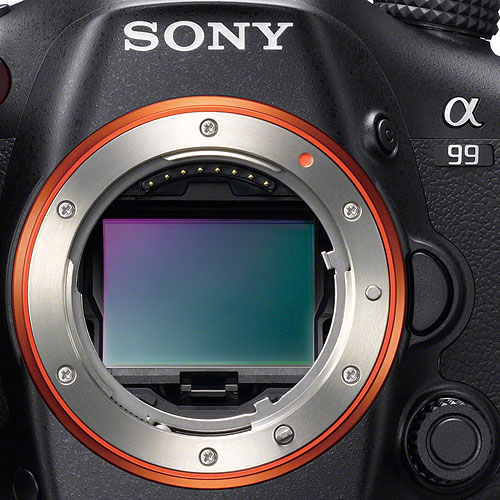
The Sony SLT-A99 features the company's Alpha lens mount, inherited in its purchase of Konica Minolta's camera division. As well as Sony's wide selection of Alpha mount interchangeable lenses, the A99 will also accept historic Minolta or Konica Minolta Maxxum lenses.
If the attached lens is supported by the feature, the A99 includes the ability to compensate for peripheral shading, chromatic aberration, and distortion.
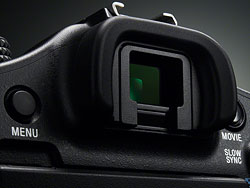
|
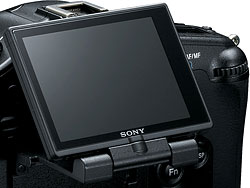
|
|
The Sony A99's Organic LED electronic viewfinder is inherited from the earlier A77 Translucent Mirror and NEX-7 mirrorless models. Resolution is an extremely high 2.4 million RGB dots, translating to 1,024 x 768 pixel array. Magnification is 0.71x, with 100% coverage and a 27mm eyepoint from the viewfinder lens. There's a -4.0 to +3.0m-1 diopter adjustment, and an eye-start autofocus sensor. One difference from the earlier cameras, though, is that color temperature of the display can now be adjusted in five steps. There's also a three-step auto/manual brightness adjustment. |
The A99's three-inch, VGA (640 x 480 pixel) rear-panel LCD display is also similar to that on the A77. It retains Sony's three-way articulation mechanism that allows viewing from in front of the camera--so long as you don't have a flash strobe mounted, anyway. It's still a TruBlack panel, which fills the air gap that causes glare and low contrast with an optical elasticity resin layer. There's one important difference, though. Instead of a standard RGB LCD panel, the Sony A99 features a WhiteMagic-branded RGBW display. Dot count hence increases to 1,228,800. The extra white dot allows either greater brightness, or lower power consumption. |
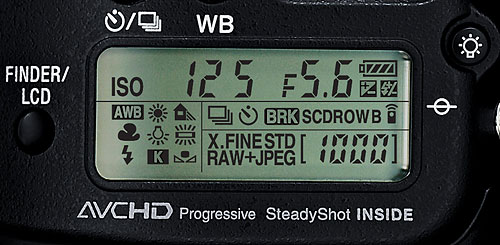
As you'd expect from a camera aimed at enthusiast and professional use, there's also a detailed, backlit top-panel info display that lets you quickly confirm camera setup.
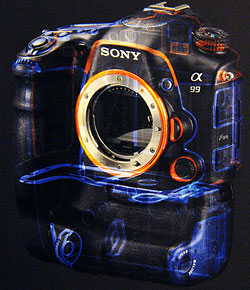
|
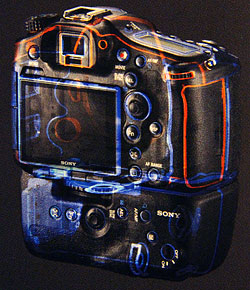
|
| The Sony A99's body is designed with reliability and all-weather use in mind. Controls are ruggedized, and there are weather seals throughout both the camera body itself, and the optionally-available vertical grip. | |
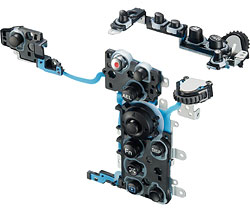
|
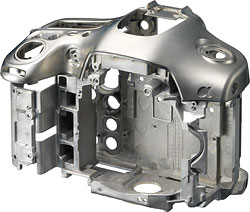
|
|
The core chassis is crafted from high-rigidity magnesium alloy with engineering plastic exterior. Sony rates the Alpha A99 as good for use in temperatures ranging from 32 to 104°F (0 to 40°C). |
|
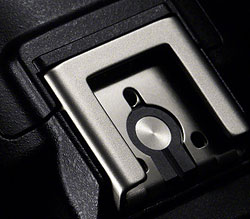
|
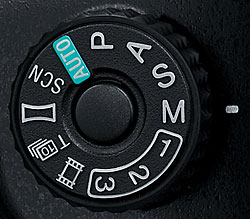
|
|
Not surprisingly given the target market, the Sony Alpha A99 doesn't include a built-in flash strobe. Instead, there's a new Multi Interface Shoe, rather than the usual proprietary hot shoe found on most Sony SLRs and SLTs. Intelligent contacts sit at the front of this new shoe, which is also compatible with ISO 518 dumb strobes. There's also a flash sync terminal on the left side of the camera body. X-sync is at 1/250 sec. Flash metering options include ADI and pre-flash TTL, and there's +/-3.0EV of flash exposure compensation with a step size of either 1/3 or 1/2 EV. Sony's wireless flash strobes are also supported, including ratio control. |
As well as the Program, Aperture- and Shutter-priority, and Manual exposure modes in which experienced photographers will spend most of their time, the Sony A99 also offers quite a few other exposure modes. These include Sony's consumer-friendly iAuto (Intelligent Auto), Superior Auto, Scene, and Sweep Panorama modes, but we're hard put to imagine many people using them on a high-end camera like this. Of more use will be the three User modes, which let you save and recall settings groups. Sony also gifts the 10 fps cropped Tele-zoom Continuous Advance Priority mode with its own position on the Mode dial. |
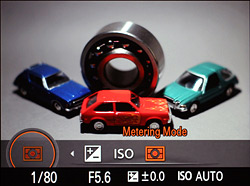
|
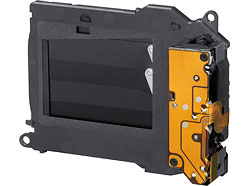
|
|
Like all of Sony's Translucent Mirror cameras, there's no dedicated metering sensor--the Alpha A99 meters exposures using the main image sensor. The A99's metering system breaks the scene down into a generous 1,200 areas, and offers a choice of multi-segment, center-weighted, or spot metering. |
Shutter speeds vary from 1/8,000 to 30 seconds for still imaging. There's also a bulb mode for exposures in excess of 30 seconds. An optional electronic first curtain function is available. Sony rates the Alpha A99's shutter mechanism as good for a lifetime of around 200,000 exposures. |
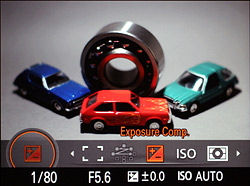
|
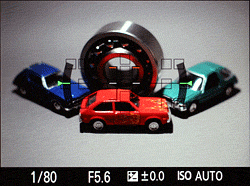
|
|
The Sony A99 offers a generous exposure compensation range of +/- 5.0 EV, in either 1/3 or 1/2 EV steps. You can also bracket exposures with three or five frames, and a step size of 1/3, 1/2, or 2/3 EV. For three-frame brackets, you can also choose a step size of 2.0 or 3.0 EV. |
To help ensure your horizons are level, and your verticals aren't converging, the Sony Alpha SLT-A99 includes a built-in level gauge function. It's a dual-axis level indicating both side-to-side roll, and front-to-back pitch, and can be shown overlaid on the live view, or in the status screen. |
The Sony A99 includes a generous selection of eleven Picture Effect functions such as HDR Painting, Partial Color, and Soft High-key. Some, such as Toy Camera, would seem to rather defeat the purpose of a US$2,800, full-frame camera, though!
There's also a healthy choice of 13 Creative Styles, which are far more likely to be used by A99 shooters needing to use JPEGs straight out of the camera. Options include everything from Neutral and Vivid to Autumn Leaves, and all offer a seven-step control of contrast, saturation, and sharpness.
Sony has also included its in-camera High Dynamic Range and Dynamic Range Optimization functions. As usual, DRO offers five strength settings and an Auto mode, while HDR can operate automatically or in 1EV steps from 1 to 6 EV. The multi-shot HDR function includes microalignment, so it will work handheld.
Also included are Clear Image Zoom and Auto Portrait Framing functions, both based on pattern matching By-Pixel Super Resolution tech. Clear Image Zoom is a 2x digital zoom Sony claims nearly equals an optical zoom. Auto Portrait Framing locates a human subject and crops your image to rule of thirds proportions, then resamples to full-res. Great for consumers, but a bizarre option to find on an enthusiast/pro camera.
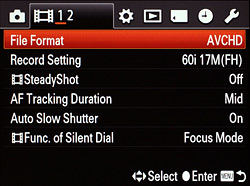
|
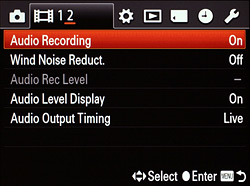
|
|
As with past Translucent Mirror cameras, Sony is emphasizing the video capabilities of the Alpha A99: SLT cameras are unique in offering full-time phase detect autofocus from a dedicated sensor. Perhaps even more significantly, the A99 is the only full-frame camera that can shoot Full HD (1,920 x 1,080 pixel; 1080p) video at up to 60 frames per second! Full HD videos are recorded in AVCHD version 2.0 format with AC-3 Dolby Digital audio, while 1,440 x 1,080 or VGA (640 x 480) video uses MPEG-4 AVC (H.264) compression with MPEG-4 AAC-LC audio. Alternatively, you can output uncompressed video via HDMI, although the bit depth isn't yet clear. Sony offers full Program, Aperture- or Shutter-priority, and Manual exposure for video shot on the A99, so you can completely control video capture to match your creative vision. |
Recognizing the difficulty of making exposure adjustments without including handling noise, Sony has gifted the Alpha A99 with a programmable multi-control dial on the front of the camera body. This is designed to provide silent operation, so that you can make adjustments without having to rely on off-camera microphones for your audio recording. And then there's the A99's audio feature set. As well as a built-in stereo mic, there's a 3.5mm stereo mic jack. You can also adjust the audio record level, and to assist you in doing so, you can connect headphones via a 3.5mm stereo output jack for levels monitoring. There's also an audio levels display function. An optional XLR-K1M kit mounts on the Multi Interface Shoe, and adds two balanced XLR connections with mic / line input selection and separate level adjustments, a unique capability in the SLR world. (A Sony ECM-XM1 mono shotgun mic is included in the kit.) |
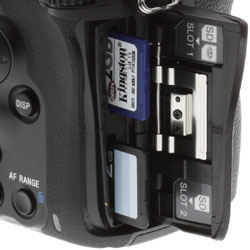
|
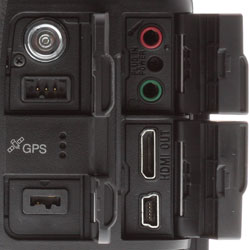
|
|
The Alpha SLT-A99 includes two storage slots. The first accepts either Secure Digital cards, or Sony's proprietary Memory Stick PRO Duo and PRO-HG Duo cards. The second drops the proprietary format in favor of SD cards only. Both slots accept higher-speed UHS-I card types. You can opt either to record stills to one card and movies to the other, JPEGs to one and raw to the other, or to have the second card simply mirror stills, movies, or both as they're saved to the first card. Still images are stored in either JPEG or 14-bit raw format, or both simultaneously. Movies are stored as AVCHD or H.264, depending upon the resolution. |
The Sony A99 offers an unusually rich selection of connectivity options. Not surprisingly , there are the usual Mini-B USB 2.0 High Speed and Type-C HDMI connections. The USB port supports Mass Storage and MTP modes, as well as remote control from an attached PC. The HDMI port is compatible with Sony's Bravia Sync and PhotoTV HD. We've already mentioned the flash sync terminal, Multi Interface Shoe, 3.5mm stereo microphone and headphone jacks. There's also a wired remote terminal, a connector for a vertical handgrip, and a DC input jack. (Phew!) |
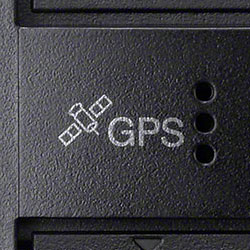
|
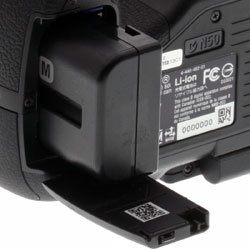
|
|
There are actually two variants of the Sony A99: either the base model, or the Sony A99V. The sole difference is that the base model doesn't include a GPS receiver, but the Alpha A99V does. That allows geotagging of your images, so you can record the location of capture. In the US market, only the Sony SLT-A99V will be offered; other markets may offer only the non-GPS version, or perhaps provide a choice of both models. |
Power comes courtesy of a proprietary lithium-ion rechargeable battery pack bearing Sony's InfoLithium branding. The same NP-FM500H pack has been used in many of Sony's recent SLR and SLT cameras, and in the Alpha A99, is said to provide a lifetime of around 410 shots on a charge with the electronic viewfinder, or 500 shots using the LCD panel to CIPA testing standards. For studio shooting, you'll want to pick up the AC-PW10AM AC adaptor kit. |
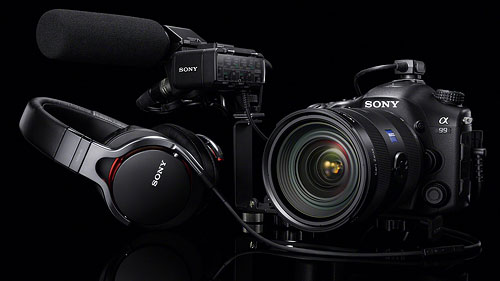
Available from October 2012 in the US market, the Sony Alpha SLT-A99V is priced at US$2,800.
The VCG-C99AM vertical grip is priced at US$380, while the XLR-K1M XLR adaptor kit will list at US$800. Other new accessories include the HVL-F60M flash strobe (US$550), HVL-RL1 ring light (US$350), RMT-DSLR2 remote commander (US$30), LCS-BP3 backpack (US$160), and PCK-LM14 screen protector (US$17).
All of these accessories became available in October 2012.
